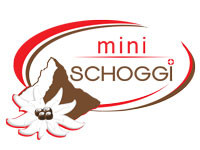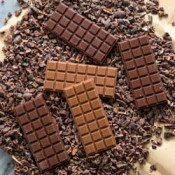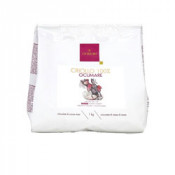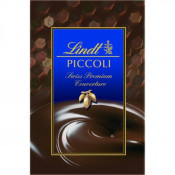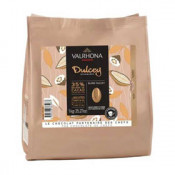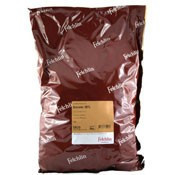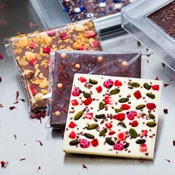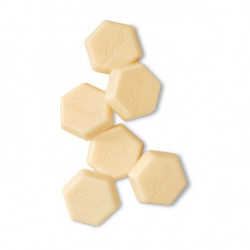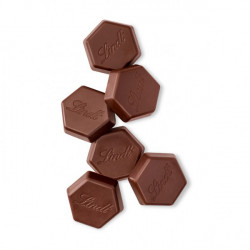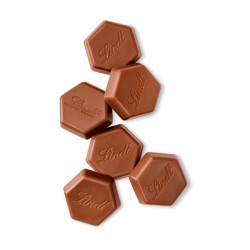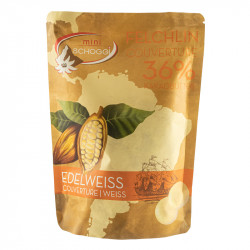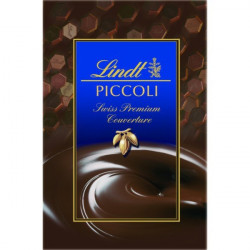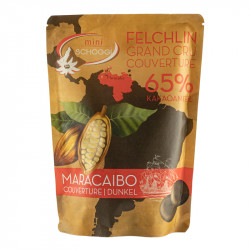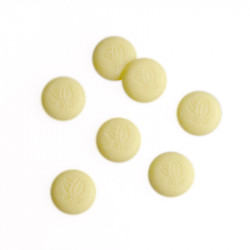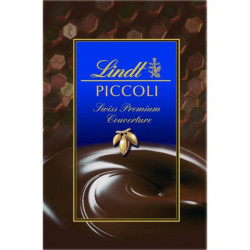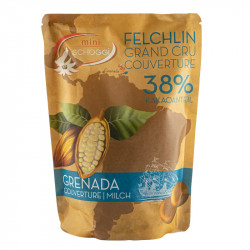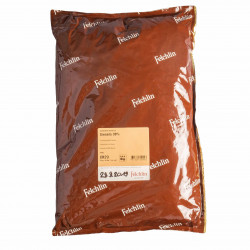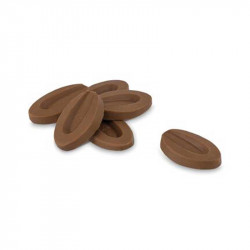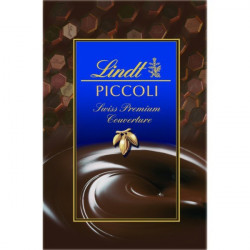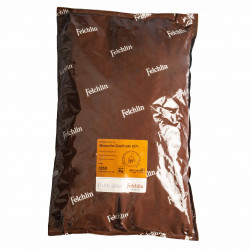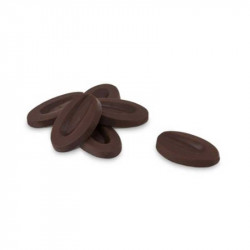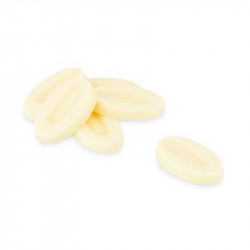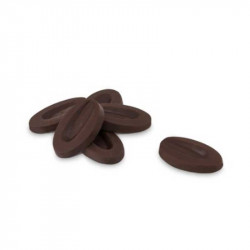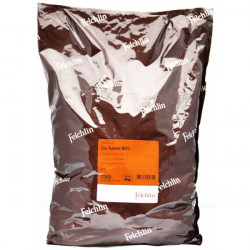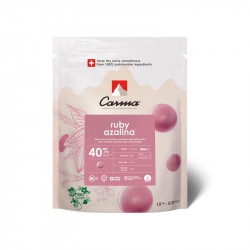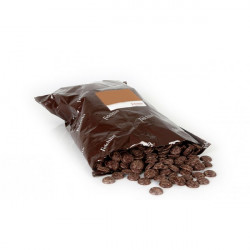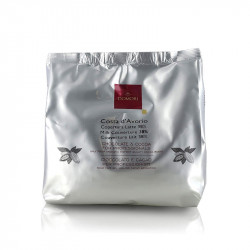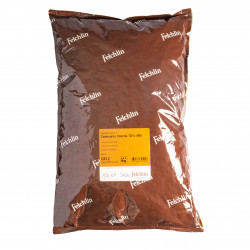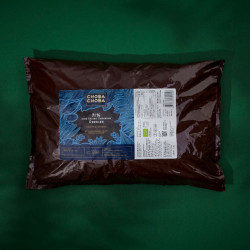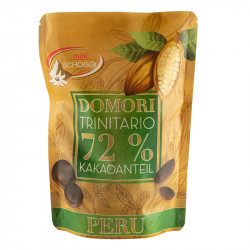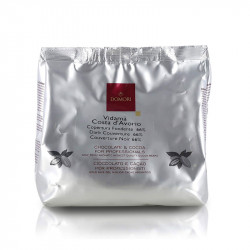Couverture
Unterkategorien
Differences between chocolate and couverture
For the production of chocolate products such as pralines, bars or chocolate figurines, we recommend always using couverture and not chocolate.
Chocolate
Normal chocolate, which is available in any supermarket, does not melt as well as couverture, because the cocoa butter content is much smaller than in couvertures. As a result, normal chocolate always remains somewhat viscous. It is difficult to cover a praline with a thin layer of chocolate with such a chocolate. You can see this difference particularly well when melting normal milk chocolate and milk couverture. Normal milk chocolate remains very viscous, whereas milk couverture can be poured nicely.
Normal chocolate also has a higher sugar content than couverture, which is why it is cheaper in the store, but also significantly sweeter than couverture when consumed.
Couverture
The couverture itself has a smaller sugar content, but a larger proportion of cocoa and cocoa butter. Since these two ingredients are more expensive to purchase, the final price of the couverture also increases. In return, you are rewarded with a more intense chocolate aroma and the flowing property is ideal for the production of chocolate bars, chocolates, chocolate figures or other chocolate specialties.
Couverture is available in different units: as a whole block, as couverture drops or as couverture shavings. We prefer couverture drops because they are the perfect size for further processing. Since high-quality couverture is hard to find, miniSchoggi offers various couvertures from different manufacturers and countries of origin in different packaging units in our large sales store in Adliswil or in our own online store. We use and sell only Swiss couverture of exquisite quality.
Why does couverture need to be tempered?
The beautiful gloss in the products made from couverture is of utmost importance and gives the final product the appetizing appearance. Responsible for the appearance and thus also for the gloss is the complex cocoa butter. This is polymorphic (present in different shapes/forms) and contains various fat groups (stearic, palmitic and oleic acids) with different melting points ranging from 20 °C to 47 °C.
These different fats have the property of solidifying into unstable and stable crystal forms on cooling. The fat components contained in cocoa butter thus consist of stable as well as unstable fat crystals. Since all couvertures contain cocoa butter, it is imperative that they be tempered to avoid compromising consistency or aesthetics. Tempering them therefore means processing their fat components (cocoa butter) in such a way that they are easier to shape and obtain the desired gloss and break after processing (whether into bars, chocolates or hollow figures).
If this is not done, the couverture can stick to the praline, table or figurine molds or take on a grayish appearance. Although this is not as visually appealing, it is harmless for enjoyment.
So you can say, if there were no cocoa butter in a chocolate or couverture, this would simplify a lot of things, because the couverture would not have to be tempered. This is exactly what was done with the cake glaze (also called fat glaze or cake melts).
Cake icing and cake melts
Cake icing is a chocolate-like substance that is not tempered but still shiny.
The application is quite simple: melt the cake glaze in a water bath, pour it over the finished cake and voilà, the cake glaze sets, becomes solid and has a beautiful sheen. With cake icing, you omit the cocoa butter completely and replace it with another foreign vegetable fat, usually coconut or palm fat. This saves the time of tempering, but in terms of taste it does not come close to chocolate or couverture.
In confectionery, cake glaze is used to coat cakes, cupcakes or confectionery, but never for high-end confectionery products such as chocolates or chocolate bars.
Which couverture requires which processing temperature?
White couverture
The main ingredients of white couverture are sugar, cocoa butter, milk powder and vanilla. The white couverture is first melted at 45 °C and then cooled down to 26-27 °C. The last step is to heat the couverture again slightly and bring it to a final temperature of 29-30 °C. Finally, the couverture is heated again slightly and brought to a final temperature of 29-30 °C.
Milk couverture
The main ingredients of milk couverture are sugar, cocoa butter, milk powder, cocoa mass and vanilla. The milk couverture is first melted at 45 °C and then cooled down to 27-28 °C. The last step is to heat the couverture slightly and then to a final temperature of 31-32 °C. Finally, the couverture is warmed slightly and brought to a final temperature of 31-32 °C.
Dark couverture
The main ingredients of the dark couverture are cocoa mass, sugar, cocoa butter and vanilla. The dark couverture is first melted at 45 °C and then cooled down to 28-29 °C. The final temperature is then increased slightly. Finally, it is heated again slightly and brought to a final temperature of 32-33 °C. In couvertures with a cocoa content of over 60%, the couverture appears much more viscous at the final temperature (32-33 °C) than dark couvertures with a smaller cocoa content. With the high percentage couvertures, it is essential to ensure that they are not reheated too firmly, even if you have the feeling that the couverture is still too cold. Couvertures with a cocoa content of over 60% may be slightly viscous during processing.
Vaccination method
In this method, stable crystals in drop form are added to the dissolved couverture. We recommend this method as it is undoubtedly the most commonly used and simplest method.
Tabulation method
Here, stable fat crystals are formed by cooling to 27 °C and moving on a cool surface.
Direct heating
Well pre-crystallized couverture can also be heated directly (30 to 33 °C, depending on the variety). It is essential to ensure that the stable crystals are not completely dissolved. This is certainly one of the most difficult methods of tempering couverture.
Tempering with the microwave oven
Place the couverturedrops in a plastic bowl in the microwave several times for a short time (20 seconds) and mix the couverture well after each heating. Repeat until the desired processing temperature is reached.
Tempering with Mycryo
By adding previously tempered and freeze-dried cocoa butter, the finished crystals can be mixed to liquid chocolate (34 °C). The added cocoa butter subsequently triggers the correct formation of the fat crystals and thus enables tempering. This relatively new method is used in a slightly modified form by the majority of the chocolate industry.
Application: Melt the desired amount of couverture at 45 °C and let it cool down at room temperature (dark couverture 34-35 °C, milk couverture and white couverture 33-34 °C). Add 1% Mycryo cocoa butter (10 g Mycryo per 1 kg couverture), mix everything well and make a sample to see if the couverture sets nicely.
Couverture vaccinate
In this method, the stable crystals are added to the dissolved couverture in drop form.
Two thirds of the couverture drops are melted to 45 °C and inoculated with one third of already tempered couverture drops (room temperature).
At a temperature of 45 °C, all stable and unstable fat crystal forms contained in the cocoa butter dissolve. By cooling and adding pieces of couverture containing the stable fat crystals, the melted couverture is enabled to form the stable fat crystal forms again.
These couverture pieces dissolve in the excessively warm couverture and are evenly distributed throughout the couverture by regular stirring. This is why this method is called the inoculation method. The liquid couverture at 45 °C, which no longer contains stable fat crystals, is inoculated with stable crystals in the form of solid, cooler (room temperature) couverture pieces.
Please note that there are various methods for the tempering process, but we recommend the inoculation method, as this is undoubtedly the simplest and most frequently used technique. The inoculation method does not necessarily require a tempering unit, a bowl over a water bath is sufficient. However, it is much easier if a tempering device is available, which allows convenient and stress-free work. After all, working with chocolate should be a lot of fun.
Tabulate couverture
In this method, stable fat crystals are formed by cooling to 27 °C and moving on a cold surface.
In the tabling method, the entire couverture is heated to 42 °C. Half of the 42 °C couverture is emptied onto a cold work surface (marble or granite table/work surface). Now the 42 °C warm couverture is cooled to 27 °C with constant back and forth stroking using an angled spatula and metal horn. The cooled couverture is then returned to the 42 °C half still in the bowl and mixed.
The stable fat crystals now formed are distributed throughout the couverture. The 42 °C warm couverture is cooled very quickly to approx. 30 °C by the addition of the couverture cooled down to 27 °C.
As soon as the couvertures are well mixed, everything must be reheated a little until the optimum processing temperature is reached.
This is undoubtedly the most elegant, but also the most cleaning-intensive method of tempering. With a little practice, it is a very speedy variant and is also very well suited for smaller quantities or self-produced bean-to-bar envelopes.
Temper couverture correctly over the water bath
Place enough water in a large pan so that the bowl you plan to use for the chocolate will not touch the water when placed on the pan. Heat the water while the bowl is still out. Once it boils, turn the temperature down to the second lowest setting. In the bowl you selected earlier, melt two-thirds of the desired amount of couverture completely. We recommend the use of a stainless steel bowl, as this conducts the heat and thus melts the couverture even faster.
Caution: No moisture should get into the couverture. Likewise, the temperature must never rise above 50 °C, as the lactose contained in the couverture begins to caramelize at too high a temperature and lumps form. This lump formation is irreversible and this couverture can no longer be used for pure chocolate products, because the caramel pieces remain even if the tempering process is repeated.
Once the couverture pieces have completely dissolved in the water bath (45 °C), remove the bowl from the pan, add a third of the couverture drops, stir well and then leave the bowl for a short time. The drops will dissolve and thus cool down the total amount until the couverture solidifies again.
Once the couverture has reached a temperature of 26 to 28 °C, heat it again over the water bath. Heat the couverture slowly so that it does not become too hot. It is better to heat the couverture to the final temperature in several small stages than to heat it too quickly and possibly burn it. Do not forget that the bowl will continue to heat up a little for a short time, making the couverture it contains about 1 to 2 °C warmer.
It is therefore better to remove the bowl with the couverture from the water bath early, shortly before the perfect final temperature, in order to avoid overheating the couverture. Reheat in small stages until the correct processing temperature is reached (30 to 33 °C depending on the type of couverture).
What exactly is couverture?
Couverture refers to a high-quality chocolate that contains a high percentage of cocoa and less sugar. It is often used to make chocolates, truffles and other chocolate specialties. Couverture has a high fat content that forms a thin, glossy layer when melted and tempered, resulting in a smooth texture. It is usually more expensive than regular chocolate and is prized by both professional chocolatiers and hobbyists.
What is couverture and what is the difference to normal chocolate?
Couverture and couverture are terms used in the world of chocolate to describe chocolate products with a higher cocoa content and special processing. Compared to traditional chocolate, couverture and couverture contain a higher percentage of cocoa butter and less sugar.
Couverture is chocolate that contains at least 31% cocoa butter. It is generally used by professional chocolatiers because it is particularly fluid when melted and processed and has a glossy sheen. Couverture is often used for coating confectionery, making chocolates and as a professional ingredient in pâtisserie.
couverture, on the other hand, contains at least 40% cocoa butter and thus has a higher fat content than couverture. This makes it particularly smooth and easy to melt. Couverture is often used by bakers and confectioners because it is well suited for glazing, decorating and filling pastries.
The difference between couverture and conventional chocolate is that it usually contains a higher proportion of sugar and milk powder to achieve a lighter and sweeter taste. Couverture and chocolate coatings, on the other hand, are more intense in flavor and offer a wider range of flavors due to their higher cocoa content and reduced additives. They are also easier to handle during melting and processing due to their high cocoa butter content.
Difference between chocolate, couverture and cake icing?
Chocolate, couverture and cake icing are different types of confectionery used to coat and decorate food. The main difference between them is their cocoa content, consistency and use.
- Chocolate: Chocolate consists of cocoa butter, cocoa mass, sugar and possibly other ingredients such as milk powder or nuts. Depending on the cocoa content, different types of chocolate can be produced, such as dark chocolate with a high cocoa content, milk chocolate with a lower cocoa content and white chocolate, which contains no cocoa mass. Chocolate is sold in bars, bars or pieces and used to make desserts, pastries or chocolate sauces.
- Couverture: Couverture is a high quality chocolate that contains a higher percentage of cocoa and a higher cocoa butter content than regular chocolate. This gives it a smoother consistency and a more intense flavor. Couverture is mainly used by professional confectioners and chocolatiers to make pralines, chocolate bars or fine desserts.
- Cake glaze: Cake glaze is a simpler form of chocolate sold in solid or liquid form in small bars or as a block. It usually consists of sugar, cocoa powder, vegetable fat and possibly other flavors or additives. Cake icing is often used to frost cakes, pastries or cookies. It has a faster drying time than chocolate or couverture and remains more solid as it cools.
In summary, chocolate is the generic term that encompasses several varieties, while couverture is a higher-quality form of chocolate with more cocoa and cocoa butter. Cake icing, on the other hand, is a simpler form of chocolate that dries faster and is commonly used to frost cakes.
Where can I buy couverture / chocolate coating?
Couverture or chocolate coating can be bought in various stores and online. You can find them in specialty stores for baking ingredients, such as miniSchoggi in the bakery store in Adliswil or in the online store of miniSchoggi. There you will find a wide selection of different couverture manufacturers such as: Lindt Couverture, Läderach Couverture, Felchlin Couverture, Valrhona Couverture or even Domori Couverture.
What is the best way to melt couverture or chocolate?
There are several ways to best melt couverture or chocolate:
1. Water bath: Fill a pot halfway with water and heat it over medium heat. In a heatproof bowl, place the couverture or chocolate and place it in the pot so that the bowl does not touch the water. Stir regularly until the couverture or chocolate is melted.
2. Microwave: Cut the couverture or chocolate into small pieces. Put them in a microwave-safe bowl and heat them in the microwave in 15-30 second intervals. Stir between intervals to ensure even melting. Be careful that the chocolate does not get too hot and burn.
3. Sous-vide method: Vacuum the couverture or chocolate in a heat-resistant bag and place the bag in water at a constant temperature of about 45-50°C. Let the chocolate melt slowly by gently moving the bag in water from time to time.
It is important to melt the couverture or chocolate slowly and gently to avoid clumping or burning. Be careful not to allow moisture to get into the chocolate, as this can cause it to clump or solidify. Chocolate is tempered to ensure it has a smooth texture, a glossy sheen, and a crisp consistency. The tempering process stabilizes the crystal structure of the cocoa butter in the chocolate, which prevents the chocolate from developing a greasy or sandy coating when it hardens. Proper tempering allows the chocolate to harden quickly as it cools, resulting in a uniform appearance and a pleasant mouthfeel.
Why do you need to temper chocolate?
Chocolate must be tempered to ensure that it has the right texture, gloss and snap (crackle) when it hardens.
Tempering involves heating the chocolate and then cooling it to a specific temperature before reheating it. This process realigns the cocoa butter crystals in the chocolate to achieve the desired properties.
When chocolate is not tempered, undesirable effects can occur, such as a dull and gray sheen, soft or greasy texture, and a lack of snap when broken. Tempered chocolate, on the other hand, has a glossy surface and is firm and crisp.
In addition, tempering also prevents the appearance of undesirable white deposits on the chocolate, known as fat bloom or cocoa butter bloom. Proper tempering minimizes the formation of these deposits.
Overall, tempering chocolate is an important step in producing high quality chocolate and ensuring that it has the desired characteristics for enjoyment.
Do I need a tempering unit to temper chocolate?
Yes, a tempering device is needed to temper chocolate properly. Tempering involves heating the chocolate to a certain temperature and then cooling it back down to form a stable crystal structure. This gives the chocolate a glossy sheen, a crisp bite and does not melt at room temperature. A tempering unit helps to temper the chocolate in a precise and controlled manner, as it can maintain a constant temperature. There are different types of tempering devices, such as melting and cooling pots, tempering devices with temperature probes and temperature-controlled chocolate fountains.
Can I also temper the couverture over a water bath?
Yes, you can also temper couverture over a water bath.
How to temper chocolate or couverture over a water bath?
To temper chocolate or couverture over a water bath, follow the steps below:
1. Fill a pot about one-third full with water and heat it on the stove. Make sure the water is not boiling, but just simmering.
2. Take a heatproof bowl large enough to melt the chocolate or couverture in. Place the bowl over the simmering water bath so that it does not touch the water. The steam will heat the chocolate evenly and gently.
3. Place the chocolate or couverture in the bowl and stir regularly so that it melts evenly. Make sure that no water or steam gets into the chocolate, as this can cause lumps.
4. Heat the chocolate until it is completely melted and has reached a temperature of about 45-50 degrees Celsius. Use a kitchen thermometer to monitor the temperature.
5. Once the chocolate has melted and reached the desired temperature, remove the bowl from the water bath. Continue stirring to cool the chocolate to a temperature of about 30-32 degrees Celsius. This is the ideal temperature to temper the chocolate.
6. One way to cool the chocolate to the desired temperature is to add a small amount of unmelted chocolate (about 1/3 of the total amount) to the melted chocolate and stir until it is completely dissolved. This will cool the chocolate and promote crystallization.
7. Check the temperature of the chocolate again with the thermometer. It should now be about 30-32 degrees Celsius.
After tempering, you can use the chocolate for pouring, dipping or decorating. Keep the chocolate at the desired temperature during use, either by reheating over a simmering water bath or using a chocolate tempering device.
What happens if you do not temper the couverture or chocolate?
Failure to properly temper the couverture or chocolate can lead to several problems:
1. Dull finish: Chocolate may have a dull and unattractive sheen after cooling instead of being glossy and smooth.
2. Gray or white coating: If the chocolate is not properly tempered, a gray or white coating may form on the surface after cooling, known as chocolate bloom. This is a sign of improper crystal formation and will affect the taste and appearance of the chocolate.
3. Poor texture: chocolate that has not been tempered properly may have a soft or grainy texture instead of being firm and crunchy. This can affect the experience of eating the chocolate.
4. Melting point: Chocolate that is not tempered evenly may not melt evenly, leading to undesirable results when used in recipes, such as frosting cookies or chocolates.
Tempering chocolate is important to ensure that the cocoa butter remains in the proper crystal structure. Proper tempering gives the chocolate the desired gloss, consistency and melting point, and extends its shelf life.
Why can a gray haze form on the surface of the chocolate?
The gray haze on the surface of chocolate is called chocolate bloom. It is a natural process caused by the crystallization of the fat components of chocolate. Chocolate contains cocoa butter as well as other types of fat, which can crystallize out when the temperature and humidity change.
When crystallizing out, the fat components accumulate on the surface of the chocolate. This results in a matte, slightly dull appearance that may be gray or whitish. This effect occurs mainly when chocolate is exposed to large temperature fluctuations, for example when it is also stored in the refrigerator.
Chocolate bloom generally affects neither the taste nor the quality of the chocolate; it is merely an optical change. The chocolate can still be eaten without hesitation. However, it may appear unsightly due to the change in appearance. To avoid chocolate bloom, it is best to store chocolate at a constant temperature between 15-20°C and as dry as possible.
What is the best way to store chocolate or couverture?
Chocolate or couverture should be stored in a cool, dry and dark place to preserve its quality and shelf life. Here are some tips for optimal storage:
- Temperature recommendation: Store the chocolate at a constant room temperature of about 15-18 °C. Avoid fluctuating temperatures as this may cause the chocolate to start melting or turn gray. Avoid fluctuating temperatures as this can cause the chocolate to start melting or form gray haze.
- Avoid humidity: Make sure the chocolate does not come into contact with moisture, as this can cause it to become lumpy or develop an unpleasant taste. Therefore, store it in an airtight container or plastic bag.
- Dark storage: Chocolate should be kept away from direct sunlight, as this can cause a change in flavor and deterioration. Therefore, store it in a dark place or in a darkened drawer.
- Avoid flavors: Since chocolate readily absorbs aromas, it should be kept away from strong-smelling foods. Therefore, store it separately from strong-smelling foods such as onions, garlic or spices.
- Refrigeration: In warm environments, it may be advisable to store chocolate in the refrigerator. However, make sure it is well wrapped to avoid moisture buildup. Before using the chocolate, let it come to room temperature slowly to avoid condensation.
By following these storage tips, you should be able to store your chocolate or couverture optimally to maintain its quality and freshness.
How long is the shelf life of couverture or chocolate?
Couverture and chocolate usually have a shelf life of at least six months up to two years, depending on the type and manufacturer. However, it is important to check the expiration date on the packaging to make sure they are still edible. Proper storage is also important to ensure shelf life. Chocolate should be stored in a cool place (around 15-18°C), dry and away from sunlight. Airtight packaging or sealed containers help preserve the quality and flavor of the chocolate.
How many different couvertures are there?
There are many different types of couverture, which can vary depending on the chocolate brand and manufacturer. There are dark, white and milk couvertures, as well as couvertures with different cocoa percentages and flavors such as fruity or nutty. It is difficult to give an exact number, as the range is constantly changing and new varieties can develop.
